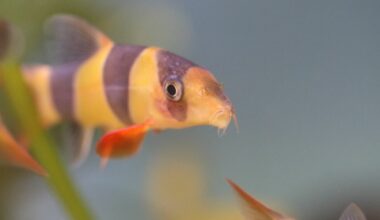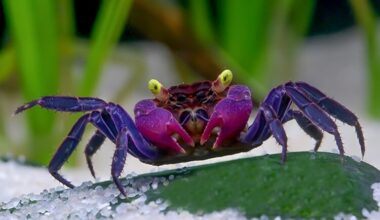This post could’ve been about baking chocolate chip cookies but we decided to stay within our field of expertise and created a care guide for the Chocolate Chip Starfish. These sea stars are fascinating not only for their tasty looks (don’t eat it though), but because they are easy to care for and have a very interesting feeding behavior eating whatever organic matter fits in their mouth.

We hope you learn enough to eventually add these amazing creatures to your saltwater tank since in this guide we cover essential topics like lifespan, tank size, diet and recommended tank mates.
Table of Contents
Species Summary
Chocolate Chip Starfish are striking sea creatures that provide beauty to aquariums and exhibit some unique behaviors that set them apart from fish and other invertebrates. These resilient omnivorous scavengers, known scientifically as Protoreaster nodosus, span the Indo-Pacific Ocean and Red Sea. They stick to the sandy shallows and seagrass beds of lagoons and back reefs.
Also nicknamed Horned Sea Stars, these creatures are typically found between 3 and 30 feet below the surface. They are relatively adaptable, surviving in various environments as long as water temperature and salinity are bearable.
Author Note: Chocolate Chips are widespread and easy to collect. Most available specimens are wild-caught. Breeding them is not worthwhile because they are plentiful in the sea. As a result, Chocolate Chip Starfish are inexpensive tank additions that will add a unique accent to your aquarium.
Appearance
Chocolate Chip Starfish have one of the aptest names in the animal kingdom. These invertebrates are usually a tannish brown shade, like a freshly baked cookie, with raised darker brown bumps resembling chocolate chips. In rare cases, Chocolates may have red, gray, or blue coloring.
The chips resemble horns, leading biologists to speculate they are a defense adaptation meant to trick would-be predators into thinking the starfish is a ferocious creature rather than a docile and easily preyed upon species. The tan coloration makes it easy for them to blend into the sandy and muddy areas where they live.

Chocolate Chips have relatively short, thick arms. They grow five limbs, but specimens with four or six are possible. The starfish’s underside features purple or pinkish tubes extending across the limbs. These “feet” allow the starfish to attach to surfaces and move.
Lifespan
Wild Chocolate Chip Starfish have a lifespan of up to 17 years. Captive starfish live between seven and ten years with proper diet and water conditions.
Average Size
These chocolate chip starfish have a wide size range, with a maximum diameter of 16 inches. The central disk, or body, can reach up to 5 inches. Each arm can grow to 5.5 inches. Most Chocolate Chips only reach 8 to 10 inches.
Researchers speculate that Chocolate Chips grow 0.8 to 1.2 inches yearly until they reach 3 inches. They then grow less than 0.5 inches per year, stopping at or usually before they reach 16 inches.
Chocolate Chip Starfish Care
Chocolate Chip Starfish are relatively easy to care for and have great longevity if you successfully acclimate them to your tank and maintain optimal water conditions. Experts recommend using the drip method over several hours. Slowly adapting the starfish to its home tank conditions maximizes its chance of survival.
Tank Size
The ideal tank size to house your Chocolate Chip Starfish should be at least 20-gallon. However, as with many fish, the larger the tank, the better. Roomier tanks typically lower stress levels and minimize potential bullying due to conflicts over space.
Water Parameters
- Water temperature: 72 to 81°F
- pH levels: 8.1 to 8.4
- Water hardness: 8 to 12 dKH
- Specific gravity: 1.021 to 1.025 sg
What To Put In Their Tank
These starfish are bottom-dwellers who need at least 4 to 5 inches of sandy substrate to crawl and settle in. You should add live rock to the tank without crowding the aquarium to give your starfish enough space to move and explore. They cannot crawl between narrow rock crevices or tight areas due to their stout bodies.
Chocolate Chips are adapted to the murky and muddy beds of lagoons and shallow reefs. They do well with low to moderate lighting.
Are Chocolate Chip Starfish Reef Safe?
Chocolate Chip Starfish will wreak havoc on a reef tank so unfortunately they are not reef safe. These creatures are like aquatic vacuum cleaners, consuming anything in their path. Chocolate Chips will indiscriminately eat coral, plant material, and invertebrates, including sea sponges, anemones, and other starfish.
Common Possible Diseases
When watching out for diseases the primary health concern for Chocolate Chip Starfish is bacterial infections, mainly Marine Ich and Velvet. These illnesses present with the development of white spots, sores, or lesions on the starfish’s body or limbs. The condition can be treated by quarantining the creature in a separate tank and administering iodine supplements or antibiotics. Poor water quality stresses starfish, raising their risk of infection.
Air exposure is an important consideration when transferring your starfish, whether into its home tank or to quarantine it. Air bubbles entering the starfish’s body can paralyze and kill them. Best practices require corralling them in a bucket and transferring them to their destination with the tank water.
This method keeps them continually submerged. If this is impractical due to tank size, you can slowly remove your starfish, limbs first, from its tank. This exposure method allows them to sense the change in conditions and close their central disk, shielding them from the air.
Author Note: Starfish can also suffer cuts and bruising from trauma sustained while moving. It’s best to monitor your starfish’s health if you notice signs of injury, but their trademark regenerative powers allow them to heal quickly.
How to tell if your Chocolate Chip Starfish is dying, and what to do?
While your starfish will often curl its arms while resting on the tank floor or rocks, curling can also be a sign of distress. If your starfish’s arms turn back and curl upwards while attached to the glass, it signals poor water quality. This position indicates the creature is trying to grab algae and debris from the water. In this case, begin monitoring the fish frequently and check water parameters. Work to stabilize conditions as quickly as possible.
A dying chocolate chip starfish will pull their limbs in, forming a ball. If you observe this behavior, contact a veterinarian immediately.
Food & Diet
Chocolate Chip Starfish’s diet is one of the fascinating parts of keeping them in your tank. They will eat whatever organic matter fits in their mouth or larger, stationary creatures they can extend their stomach around and consume. Once they digest the meaty parts, they will eject the brittle components, like shells.
They eat shrimp, squid, bivalves, pieces of fish, and other meaty seafood. You can place invertebrates around your tank when you shut off the lights for the evening. The starfish will effortlessly identify them and crawl to the meal.
You can also try more targeted feedings if you have a busy community tank. While starfish can locate food without difficulty, they are slow-moving scavengers. Quick-moving fish will beat them to the meal. Another option is to pick up your starfish and place it atop its food.
Author Note: Experts suggest offering food every few days and monitoring your starfish’s consumption.
Behavior & Temperament
Chocolate Starfish are peaceful creatures who will not confront other tank inhabitants over territory or food. However, they are tireless eaters who consume everything they encounter, including invertebrates and coral.
Starfish have unique anatomy, using a tube system to circulate water through their body. This vascular process powers their tube-like feet for movement and opens and closes their mouths. Chocolate Chips’ dependence on water is why they cannot tolerate air bubbles entering their bodies.

Starfish have exceedingly small mouths relative to their body size. They can easily swallow small invertebrates, plant matter, and other tiny organisms. They break down the meal and then regurgitate the undigestible parts.
However, they can also take on larger prey through eversion. This process involves ejecting the stomach from the starfish’s body through its mouth. The organ then breaks down the meal externally. The material turns into a liquid that the starfish can then drink up.
Author Note: You will sometimes observe the starfish slowly working around the substrate, looking for biofilm and algae. They will also cling to the live rock and walls of your tank. This behavior is normal and allows you to observe the starfish’s unique underbelly and tubes.
Chocolate Chip Starfish Tank Mates
Your Chocolate Chip will do well in a tank with peaceful fish and larger non-predatory invertebrates. Possible tank mates include:
- Blue Damselfish
- Butterflyfish like the Copperband Butterflyfish
- Camel Shrimp
- Clownfish
- Dwarf Angelfish
- Peppermint Shrimp
- Red Fire Shrimp (a higher grade of the Cherry Shrimp)
- Skunk Cleaner Shrimp
- Tangs (like the Purple Tang)
Avoid keeping Chocolate Chips alongside large, aggressive predators like Triggerfish (the Clown Triggerfish is one of them), Pufferfish (like the Dwarf Pea Puffer), Parrotfish, and Boxfish. Predatory crustaceans like the Harlequin Shrimp (see Harlequin Shrimp Eating a Starfish) and Arrow Crabs may hunt and devour your starfish. Chocolate Chips are meaty and slow-moving, making them prime targets for predators.
Breeding
Chocolate Chip Starfish can reproduce at 2 to 3 years old. These creatures are usually mature once they reach about 3 inches in diameter. Starfish reproduce sexually. Males and females are identical, making it impossible to sex these invertebrates without a microscope.
In the wild, Chocolate Chips move to deeper waters within their habitat to breed between March and May. They mate during full moons, which coincide with higher water temperatures and slightly decreased salinity. Chocolate Chips spawn in mass, with males releasing sperm and females releasing eggs. The genetic material then mingles based on ocean currents and luck. Fertilized eggs are less than 0.2 mm and take months to develop beyond their larval stage.
Starfish will mate in captivity, but having a member of each sex is a chance. There are no clear protocols for breeding Chocolate Chip Starfish. Simulating the necessary depth in a home tank is impossible. Additionally, there is no way to spot fertilized eggs and harvest them before tank mates consume them.
Wrapping Up
Although not reef safe, these good looking Chocolate Chip Starfish could be a great addition to your saltwater tank.
You just have to make sure the tank is large enough to minimize stress levels, and to keep it away from large predators so you can enjoy almost two decades of this amazing sea star!
If you have an Chocolate Chip Starfish you are probably sharing some cool photos on social media so don’t forget to tag us on Facebook.
And if you are looking to learn about other saltwater fish take a look at our care guides. Good luck!

